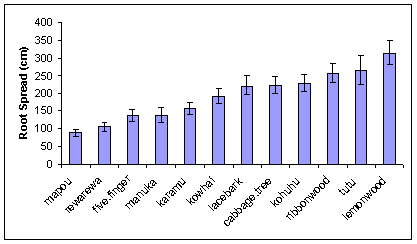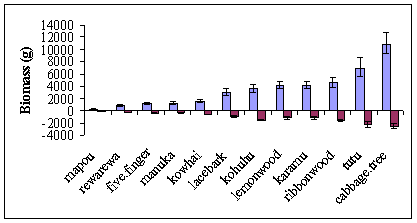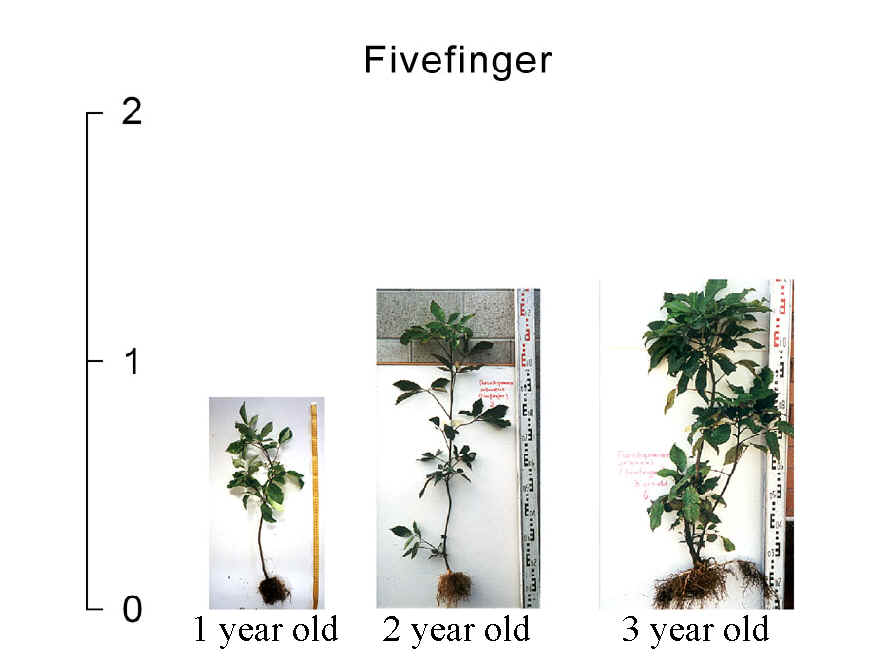Trial 1
The results from trial one are summarised in a series of posters (click on the species to download the photo).
Common Name |
Botanical Name | File size |
| Karamu | Coprosma robusta | |
| Ribbonwood | Plagianthus regius | |
| Kowhai | Sophora tetraptera | |
| Lemonwood | Pittosporum eugenoides | |
| Kohuhu | Pittosporum tenuifolium | |
| Lacebark | Hoheria populnea | |
| Mapou | Myrsine australis | |
| Fivefinger | Pseudopanax arboreus | |
| Cabbage tree | Cordyline australis | |
| Rewarewa | Knightia excelsa | |
| Manuka | Leptospermum scoparium | Incomplete results |
| Tutu | Coriaria arborea |
To summarise the results from Trial 1, we find that for an individual plant species, its "performance" relative to the other species changes according to the parameter in question.
While most of the trial species exhibited similar values for each parameter for the first 2 years of growth, ribbonwood outperformed all the species for two parameters – above- and below-ground biomass - and was second to tutu in lateral root spread. The relative position of these species changed as the plants grew and at age 5, cabbage tree was a top performer for a number of growth attributes.

Root spread Year 5
Root studies of plants less than 2 years old, are commonly affected by factors in their early life in the wild or in the nursery such as wrenching, root training and constriction in planter bags. It is likely that these factors may have contributed to some of the the early differences seen in the data, rather than the results being truly representative of an inter-species difference.
Results for 5-year-old plants are also presented in this poster from 2003. Performance of native riparian plants - how different are they? ![]() 589 KB
589 KB
The trial was completed in 2004 when the plants were 5 years old.

Above and below-ground biomass Year 5

Illustration of fivefinger at ages 1, 2, and 3 showing development of above- and below-ground features
A new trial was established in May 2006 with the aim of examining some species of podocarps and some non-woody species used in riparian restoration. The same site and methodology will be used in trial 2.
Relevant publications
Marden, M.; Rowan, D. and Phillips, C.J. 2005: Stabilising characteristics of New Zealand indigenous riparian colonising plants. Plant and Soil 278: 95-105.
Czernin, A. and Phillips, C.J. 2005. Below-ground morphology of Cordyline australis (New Zealand cabbage tree) and its suitability for riverbank stabilisation. NZ Journal of Botany 43: 851-864.
Landcare Research 2003. Researchers measure growth of native youngsters. Discovery, Issue 6, 2003, p5.
Ekanayake, J.C.; Phillips, C.J. 2002. Slope stability thresholds for vegetated hillslopes: a composite model. Canadian Geotechnical Journal 39: 849-862.
Marden, M.; Phillips,C.J.; 2002. How do native riparian plants grow? Conservation Quorum, Issue 26, 14-15.
Phillips, C.J. 2001. Soil stabilising characteristics of native riparian vegetation in New Zealand. Paper presented at NZARM Annual Conference, Hamilton, 19-21 September 2001.
Phillips, C.J.; Marden, M.; Rowan,D.; Ekanayake, J.C. 2001. Stabilising characteristics of native riparian vegetation in New Zealand. In: Proceedings of 3rd Australian Stream Management Conference, Brisbane August 2001, 507-512.
Watson, A.; Phillips, C.; Marden, M.2000: Root strength, growth, and rates of decay : root reinforcement changes of two tree species and their contribution to slope stability. In: Stokes, A. ed. The supporting roots of trees and woody plants: form, function and physiology. Dordrecht, Kluwer Academic. Pp. 41-49.
Phillips, C.J.; Ekanayake, J.C.; Marden, M., Watson, A. 2000. Stabilising-Parameters of Vegetation: A Critical Look Down-Under. In: Proceedings of Landscape 2000, Leura, NSW, Australia, 16-20 October 2000. (Conference proceedings on CD).
Marden, M.; Phillips, C.J. 2000. Using native plants to provide stability to streambanks. Conservation Quorum Issue 21, Winter 2000, p6.
Ekanayake, J. C.; Phillips, C. J. 1999. A model for determining thresholds for initiation of shallow landslides under unsaturated conditions in the E. Coast region, New Zealand. Journal of Hydrology(NZ), 38(1): 1-28.
Ekanayake, J.C.; Phillips, C.J. 1999. A method for stability analysis of vegetated hillslopes: an energy approach. Canadian Geotechnical Journal 36: 1172-1184.
Watson, A.J.; Marden, M.; Phillips, C.J. 1999. Root strength, growth and rates of decay: root reinforcement changes of two tree species and their contribution to slope stability. Plant and Soil 217: 39-47.
Ekanayake, J.C.; Phillips, C.J.; Marden, M. 1999. A comparison of methods for stability analysis of vegetated slopes. In: First Asia-Pacific Conference and Trade Exhibition on ground and water bioengineering for erosion control and slope stabilisation. April 19-21, 1999, Manilla, Philippines.
Phillips, C.J.; Ekanayake, J.C.; Marden, M. 1999: Can planting pattern make a difference to slope stability? Conservation Quorum. 17: 14.